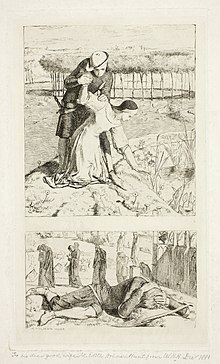Editions
The Germ was printed by Messrs. Tupper and Sons, a firm of lithographic and general printers in the City of London, who took a financial stake in the publication to try to ensure its success. Only 70 of the first issue of 700 copies were sold. The print run was reduced for later editions, but sales did not pick up. The Tupper family had links to the Brotherhood. George Tupper bore the brunt of the financial losses.
A special limited edition (only 450 copies) of all four volumes of The Germ was published in 1898 on Van Gelder handmade paper, by Thomas B. Mosher, Portland, Maine, USA.
A facsimile edition of all four volumes plus "Preface" by W.M. Rossetti was published by Elliot Stock in 1901 and issued in a slipcase.
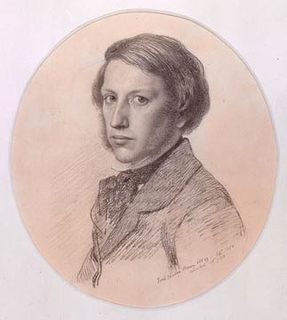
Ford Madox Brown was a British painter of moral and historical subjects, notable for his distinctively graphic and often Hogarthian version of the Pre-Raphaelite style. Arguably, his most notable painting was Work (1852–1865). Brown spent the latter years of his life painting the twelve works known as The Manchester Murals, depicting Mancunian history, for Manchester Town Hall.
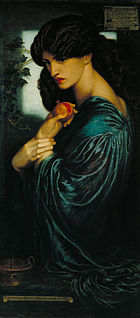
The Pre-Raphaelite Brotherhood was a group of English painters, poets, and art critics, founded in 1848 by William Holman Hunt, John Everett Millais, Dante Gabriel Rossetti, William Michael Rossetti, James Collinson, Frederic George Stephens and Thomas Woolner who formed a seven-member "Brotherhood" modelled in part on the Nazarene movement. The Brotherhood was only ever a loose association and their principles were shared by other artists of the time, including Ford Madox Brown, Arthur Hughes and Marie Spartali Stillman. Later followers of the principles of the Brotherhood included Edward Burne-Jones, William Morris and John William Waterhouse.

Thomas Woolner was an English sculptor and poet who was one of the founder-members of the Pre-Raphaelite Brotherhood. He was the only sculptor among the original members.

Gabriel Charles Dante Rossetti, generally known as Dante Gabriel Rossetti, was an English poet, illustrator, painter, and translator, and member of the Rossetti family. He founded the Pre-Raphaelite Brotherhood in 1848 with William Holman Hunt and John Everett Millais. Rossetti inspired the next generation of artists and writers, William Morris and Edward Burne-Jones in particular. His work also influenced the European Symbolists and was a major precursor of the Aesthetic movement.

Christina Georgina Rossetti was an English writer of romantic, devotional and children's poems, including "Goblin Market" and "Remember". She also wrote the words of two Christmas carols well known in Britain: "In the Bleak Midwinter", later set by Gustav Holst, Katherine Kennicott Davis, and Harold Darke, and "Love Came Down at Christmas", also set by Darke and other composers. She was a sister of the artist and poet Dante Gabriel Rossetti and features in several of his paintings.

Elizabeth Eleanor Siddall, better known as Elizabeth Siddal, was an English artist, poet, and artists' model. Significant collections of her artworks can be found at Wightwick Manor and the Ashmolean. Siddal was painted and drawn extensively by artists of the Pre-Raphaelite Brotherhood, including Walter Deverell, William Holman Hunt, John Everett Millais, and especially by her husband, Dante Gabriel Rossetti.

Frederic George Stephens was a British art critic, and one of the two 'non-artistic' members of the Pre-Raphaelite Brotherhood.

William Michael Rossetti was an English writer and critic.

James Collinson was a Victorian painter who was a member of the Pre-Raphaelite Brotherhood from 1848 to 1850.

Charles Allston Collins was a British painter, writer, and illustrator associated with the Pre-Raphaelite Brotherhood.

The Hogarth Club was an exhibition society of artists, based at 84 Charlotte Street, Fitzrovia, London, UK, which existed between 1858 and 1861. It was founded by former members of the Pre-Raphaelite Brotherhood after the original PRB had been dissolved. It was envisaged that the club would provide an alternative meeting space and exhibition venue to overcome prejudice against the Pre-Raphaelites at the Royal Academy. Unlike the PRB, the Hogarth Club was established on a professional basis, with two classes of members, artistic and non-artistic, and a distinction between London-based "resident" and provincial "non-resident" members.

Alexander Munro was a British sculptor of the Pre-Raphaelite movement. He concentrated on portraiture and statues, but is best known for his Rossetti-influenced figure-group Paolo and Francesca (1852), which has often been identified as the epitome of Pre-Raphaelite sculpture.
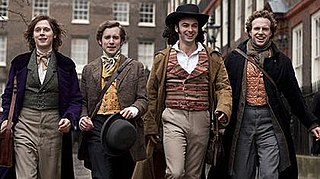
Desperate Romantics is a six-part television drama serial about the Pre-Raphaelite Brotherhood, first broadcast on BBC Two between 21 July and 25 August 2009.

The Love School is a BBC television drama series originally broadcast in 1975 about the Pre-Raphaelite Brotherhood, written by John Hale, Ray Lawler, Robin Chapman and John Prebble. It was directed by Piers Haggard, John Glenister and Robert Knights. It was shown during January and February 1975. It includes six episodes, each episode is 75 minutes in length.

Rossetti and His Circle is a book of twenty-three caricatures by English caricaturist, essayist and parodist Max Beerbohm. Published in 1922 by William Heinemann, the drawings were Beerbohm's humorous imaginings concerning the life of Dante Gabriel Rossetti and his fellow Pre-Raphaelites, the period, as he put it, "just before oneself." The book is now considered one of Beerbohm's masterpieces.

Georgiana, Lady Burne-Jones was a painter and engraver, and the second oldest of the Macdonald sisters. She was married to Pre-Raphaelite Brotherhood artist Edward Burne-Jones, and was also the mother of painter Philip Burne-Jones, aunt of novelist Rudyard Kipling and Prime Minister Stanley Baldwin, confidante and friend of George Eliot, William Morris, and John Ruskin. She was a Trustee of the South London Gallery and was elected to the parish Council of Rottingdean, near Brighton in Sussex.

Catherine Madox Brown Hueffer, also known as Cathy, the first child of Ford Madox Brown and Emma Hill, was an artist and model associated with the Pre-Raphaelites and married to the writer Francis Hueffer.
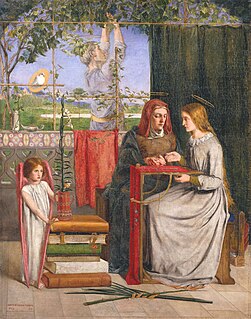
The Girlhood of Mary Virgin is an 1849 oil on canvas painting by the Pre-Raphaelite Brotherhood painter Dante Gabriel Rossetti, measuring 83.2 by 65.4 cm and now in the collection of Tate Britain, to which it was bequeathed in 1937 by Agnes Jekyll. It was his first completed oil painting and is signed "Dante Gabriele Rossetti P.R.B. 1849". He first exhibited it at the 'Free Exhibition' at the Hyde Park Corner Gallery.

Ligeia Siren is a chalk drawing by Dante Gabriel Rossetti (DGR) that was completed in 1873. The painting depicts a siren, a creature from classic Greek mythology, that also appear in tales such as Homer's Odyssey or Virgil's Georgics. The drawing is predominantly inspired from Rossetti's own 1869 libretto The Doom of the Sirens with which Ligeia is one of the female leads. Instead of depicting the traditional encounter of the siren with her victims entranced by her beauty and powers of music, doomed to a terrible fate, as in The Siren (1900) by John William Waterhouse or Ulysses and the Sirens (1909) by Herbert James Draper. Rossetti depicts a timeless moment, where contrary to his depiction of her in his libretto, she appears tranquil and relatively innocuous to her intended victims in the background.

Venus Verticordia (1864-1868) by Dante Gabriel Rossetti is a semi-nude depiction of the goddess Venus, portrayed as a young woman with a golden halo and flowing auburn hair, surrounded by pink flowers in a dark, lush green garden. Her left breast is visible, the right obscured by the golden apple she holds in her left hand. In her right hand she holds an arrow, the point directed towards her own heart, and on which rests a small yellow butterfly. Other similar butterflies ring the halo surrounding her head, and another sits on top of the apple she holds.
